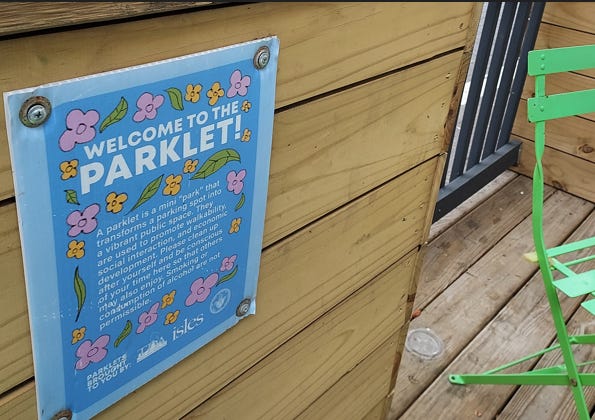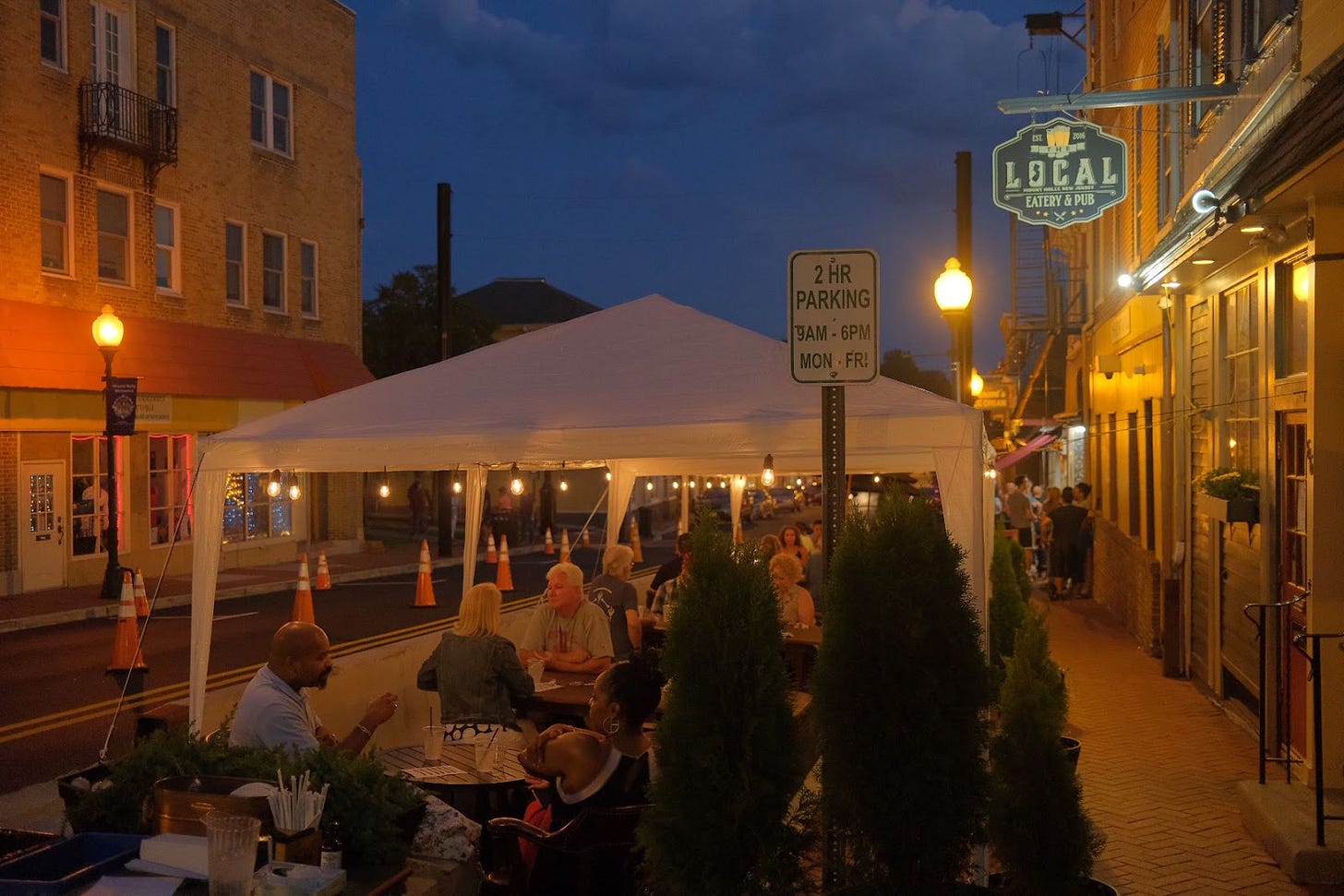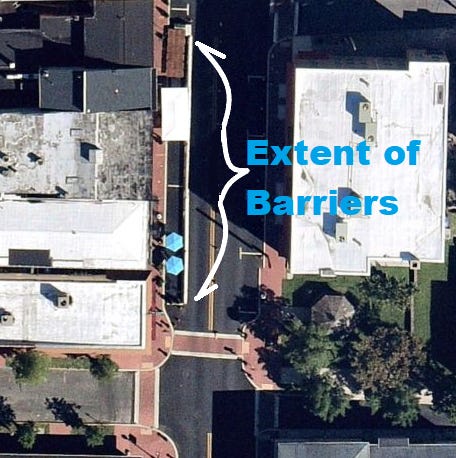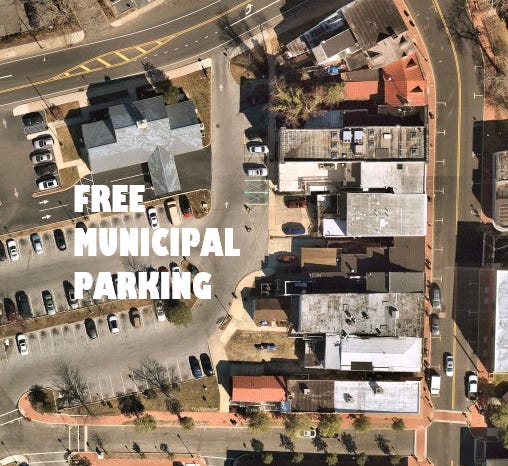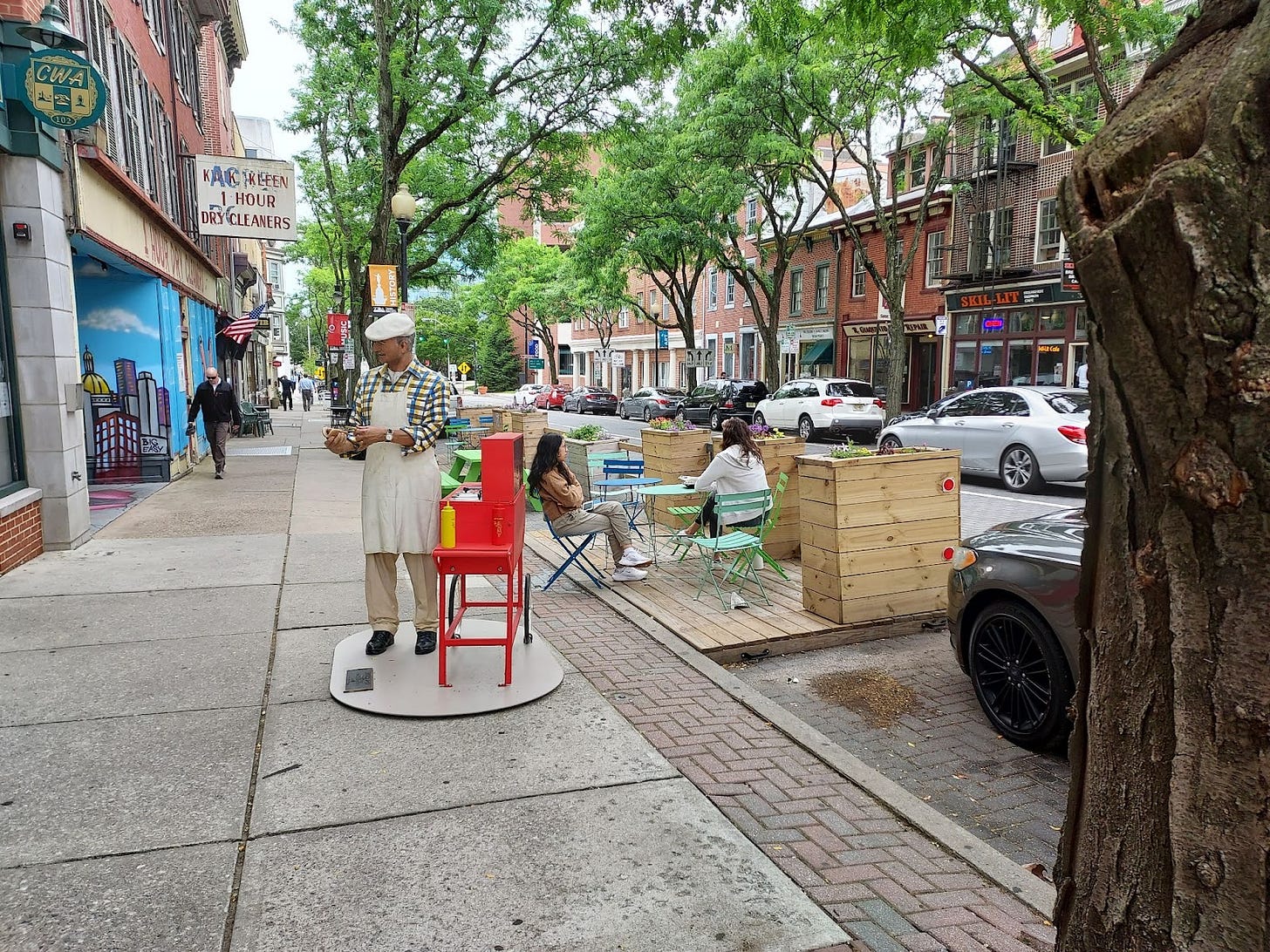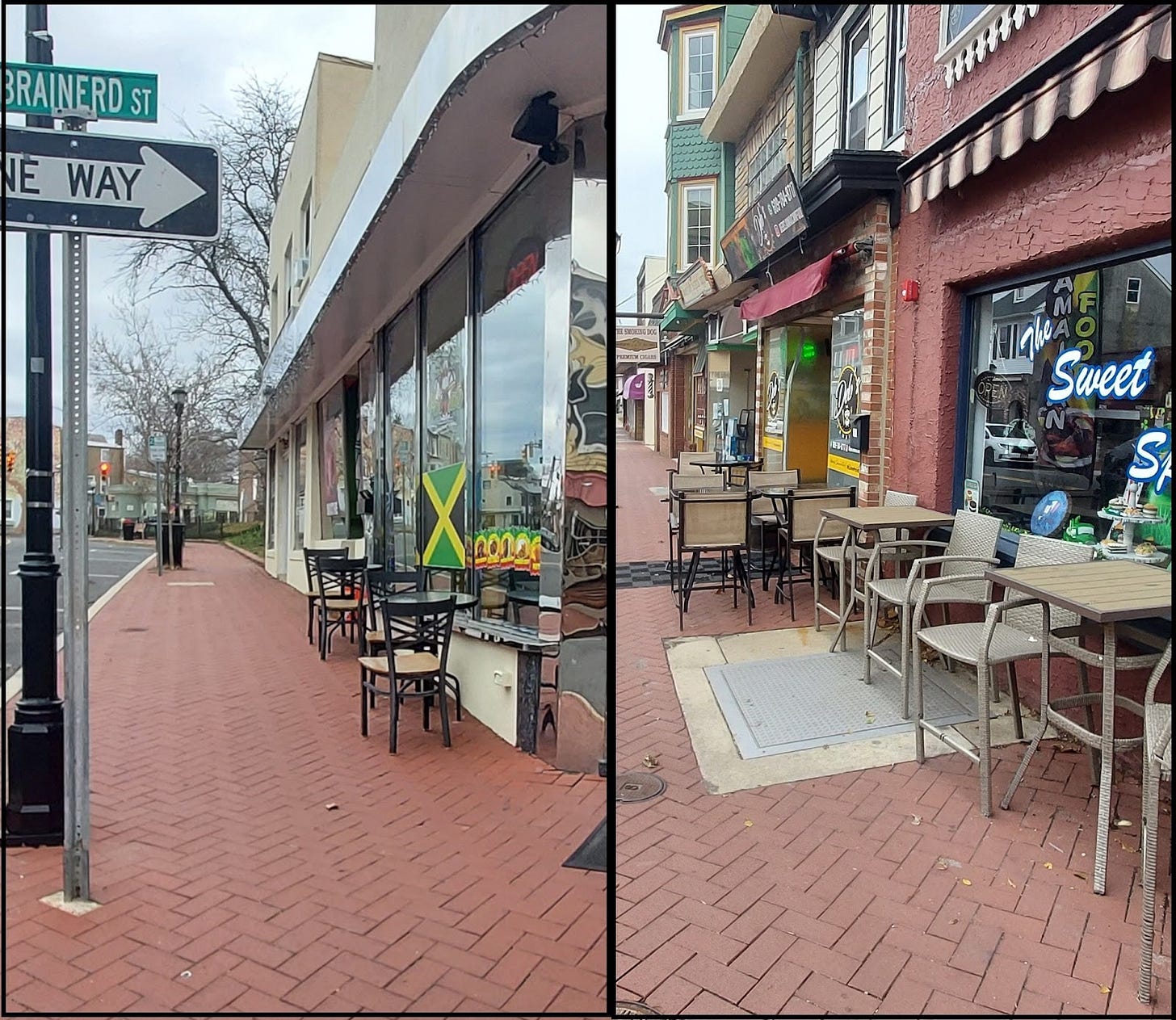Parklets: Why Don’t We Have Them?
Exploring the Past and a Possible Future of Street Dining in Mount Holly
By Leah Cruz, Special to The Reporter from The College of New Jersey
SUMMARY: COVID caused changes to American commerce, culture, and employment. Some of these changes, like remote work and distracted driving are contentious subjects not covered in this article. But one pandemic outcome that received universal affection is outdoor dining. Introduced as an emergency measure to save failing restaurants, it quickly became so popular that New Jersey codified the practice in December of 2024. Many towns repurpose parking spaces for outdoor dining by placing fortified wooden platforms in the spot. This creates a visually pleasing space generally referred to as a “Parklet”. But in 2021 Mount Holly administrators decided outdoor dining should depart along with the pandemic restrictions. Disappointed local merchants wanted to see a return of street dining but were told that would not happen. The Mount Holly Reporter attempted to find out how this decision was made.
Trenton City Promoting Walkability and Social Interaction with Parklets.
Editor’s Note: When this story surfaced in 2021, High Street merchants were eager to speak out about municipal decision-making. The last four years caused memories to fade and stories to change. What is offered for your consideration here is the best reconstruction of events from that time based on notes, photography, new interviews, and common sense.
When the world shut down in March of 2020 due to the COVID-19 pandemic, New Jersey declared a public health emergency that led to strict dining-out protocols. By the end of March, indoor dining in all restaurants and bars was ordered to be closed. The only options for customers were takeout and delivery services. The public was told these measures aimed to "bend the curve" of rising infections and reduce pressure on hospital capacity to provide care.
As months of isolation and quarantine went on, restaurants and cities realized that a solution to the indoor dining ban was needed quickly in order to keep merchants in business. By late June 2020, the Governor proclaimed that outdoor dining was permitted wherever it could be accomplished in compliance with Department of Health protocols.
High Street, Mount Holly: The popularity of outdoor dining during the Pandemic was undeniable. Notice the traffic cones which shift traffic previously separated by the double yellow lines.
In Mount Holly, outdoor dining thrived and became a helpful addition for some local restaurants to continue operations during the pandemic. While the Governor's Executive Order allowed outdoor dining, it also allowed indoor dining at 25% of restaurant capacity. This compromise between indoor and outdoor dining was a priority for business, but as indoor restrictions eased, the ability to continue outdoor dining in street spaces encountered resistance from a different priority: traffic safety.
High Street, Mount Holly: The concrete barrier protecting diners is in place in this September 2020 aerial image. Credit: Near Map
By March of 2021, the State was near a complete lifting of restrictions on indoor gatherings, and local merchants found that the concrete barriers previously placed outside had been removed. The five parking spaces previously dedicated to outdoor dining were reclaimed by the town for vehicles.
As word spread about the loss of a very popular policy, questions were raised about the reason for this decision. With ample free parking within a few hundred feet, 5 parking spaces seemed a weak reason to eliminate street dining.
Mount Holly: Municipal parking near High St. March 2021 aerial image. Credit: Near Map
THE MEETING
In 2021, residents became aware of a meeting in which former Mayor Jones and former Police Chief Spitler met with merchants to discuss the return of outdoor dining. A recent interview with former Council Member Katherine McCandless confirmed that "The Township manager told me that only the Mayor and Chief of Police attended [the meeting] for the township. I didn't have details about what was said."
Neither former Mayor Jones nor the former Chief responded to requests for comment, but what is clear is that one or both of them rejected the notion that tables would return to High Street.
At the time, a merchant who attended the meeting stated that two rationales were given. The first is that High St. is too narrow for two-way traffic with the concrete barriers in place and the second being that County officials removed the barriers.
The Mount Holly Reporter contacted a County official and was told that the County did not make the decision to remove the barriers. The same official stated that Mount Holly had indeed inquired about adequate lane width. Based on initial reports that lane width was a concern of the Police and on the photographic evidence that Police had shifted the lanes [see outdoor dining image] it appears likely that the MH Police Department rejected street dining because concrete barriers created a traffic peril by crowding into the southbound lane of High Street.
HOW DO OTHER TOWNS ACCOMPLISH PARKLETS?
Many municipalities in New Jersey have integrated outdoor dining laws on a local level, ensuring that parklets can remain a permanent feature. Collingswood, NJ was an early adopter of parklets when it launched its program in 2013 - years before the pandemic began. This initiative allowed businesses to expand dining space into streets while maintaining a pedestrian-friendly environment. Parklets in Collingswood have since become a beloved part of the town’s culture.
Relating back to Mount Holly’s traffic concern, the City of Trenton provided merchants with a traffic guidance document for parklets. The guidance specifically addresses the issue of lane width as follows: Parklets shall not be any wider than the parking lane. The outside edge of the Parklet railing shall be 18” from the travel lane, creating an 18” clear zone.
If Mount Holly adopted such a rule, it could ensure that the southbound lane of High Street would not be impinged by a concrete barrier [because parklets do not use such barriers] and could be constructed 18 inches back from the travel lane. As for insurance and liquor consumption considerations, Mount Holly could follow Trenton’s lead and place the insurance liability for the parklet onto the business’s policy and require those with liquor licenses gain an expansion from the NJ Division of Alcoholic Beverage Control.
Trenton took a stepwise approach to parklets, integrating them into its city planning with specific guidelines. The city’s program is a collaboration with a nonprofit organization called Isles and the Trenton Downtown Association. Initially, the program launched with a single parklet on West State Street, and as it proved successful, the city expanded it.
According to Anthony Santora, the chief of traffic maintenance and operations in Trenton, the city was able to get the parklet program approved in order to support struggling businesses, resulting in seven new parklets across the city. Trenton's model shows how cities in NJ can balance safety concerns with business-friendly policies, something that could serve as a reference for other towns like Mount Holly.
Trenton, NJ: Outdoor dining on Warren Street covering about 3 parking spaces.
WHY DOESN'T MOUNT HOLLY HAVE PARKLETS?
According to former councilman Jim Codianni, who served as government liaison to the Mount Holly’s business community, some business owners felt that street tables were rolled out in a way that favored only a select few establishments. Codianni stated that Council considered various alternatives for expanding outdoor dining, such as using the parking lots behind High Street. Other solutions were debated, such as closing the entire street to traffic on certain days to allow outdoor dining, but law enforcement reportedly resisted this idea. Summing up his thoughts on how Mount Holly Council viewed parklets, Codianni said
“No one person was adamantly against [parklets] but nobody championed them either, myself included.”
Katherine McCandless noted that she "brought up a notion similar to this Parklet idea during my time in office [2018 - 2021]. I asked the Manager and other Council members to consider providing similar welcoming places for people to sit and have a coffee. But the idea was immediately met with negativity about safety and cleanup problems from idle people who could use the spaces as all-day hangouts. My thought was that many other municipalities created inviting environments in their downtown with benches and planters. It would make customers and merchants feel good about the downtown. I know that many towns including Hoboken, Collingswood and Trenton somehow figured it out. Why can't we?"
A CLEAR PREFERENCE FOR OUTDOOR DINING
Mt. Holly: High Street Merchants attempt to squeeze outdoor dining onto sidewalks
While the future of outdoor dining in Mount Holly is still looking for a “Champion” on Council, just a glance at sidewalks in town reveals a merchant class ready for street tables. They make do with small tables and chairs crowded onto sidewalks that are not wide enough to comfortably accommodate pedestrians, streetlamps, signs, and dining.
Recognition of the benefits of a parklet program is now a statewide law. Perhaps local business owners may recognize how successful these programs are in other cities, how achievable a parklet program could be right here and start to advocate for one in Mount Holly.



